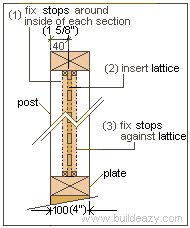Contents
About Lattice
A wood lattice consists of diagonal or vertical and horizontal strips of wood (laths) cris-crossing to make a grille like pattern.
Lattice is suitable for trellis or as decorative sections in fences, handrails, arbors, pergolas, garden or deck privacy screens, windbreaks etc.
The two most common lattice profiles are diagonal and square. (more explanation below)
Lattice section sizes (panels) can be cut to order by manufacturers or ready made panels can be purchased at most building supply stores. Typical sheet sizes are 600mm (2ft) x 2400mm (8ft) and 1200mm (4ft) x 2400mm (8ft).
Diagonal lattice
Diagonal lattice for outside use is made up of natural decay resistant or treated wood strips (laths) running opposite ways and fixed together with (usually) stainless staples.
The laths can vary in size but mostly range between 6mm (7/32″) thick to 12mm (1/2″) thick and between 12mm (1/2″) wide to 50mm (2″) wide.
The gaps between the laths can also vary greatly in size and usually depends on what the lattice is used for (privacy, windscreen, to support plants, vines etc.).
Gaps can also vary within the same section as shown in fig.2
Square lattice
The structure of square lattice is the same as that of diagonal lattice except the wood strips (laths) run vertical and horizontal rather than diagonal.
Lattice stops
The stops are the strips of wood that are used to hold the lattice in place and are fixed to the rails and posts.
25mm x 25mm (1″x1″) square stops are common, but other sizes and shapes can be used.
Stops are an alternative to using grooved U mold (also called capping or C mold)
U mould (capping)
U mold is a grooved capping that fits around the perimeter of a lattice section or panel and gives a neat picture frame appearance.
The groove in the capping is the same width (or slightly bigger) than the thickness of the lattice.
How to fit lattice into a frame
The Frame
- The lattice frame usually consists of uprights (posts) and top and bottom plates.
- The uprights, in a lot of cases are posts either concreted into the ground or bolted to another structure such as a deck or retaining wall.
- An upright may be a post for a fence, a pergola, an arbor, a screen, among other things. Usually a post is either 100×100 (4×4) or larger in size and can be either smooth (dressed) or rough (rough sawn).
- The plates are the completion of the lattice frame and run horizontal between the posts, one at the top (top plate) and one at the bottom (bottom plate).
- The plates are usually 100×50 (2×4) or larger . The plates can be a bigger size especially if the span is greater than 1800mm (6ft) although it is not advisable to have a lattice frame section spanning more than 1800mm (6ft).
Fitting the Lattice:
Notes
Lattice panel can be cut to order or purchased in ready made panels in sizes such as 600mm (2ft) x 2400mm (8ft) or 1200mm (4ft) x 2400mm (8ft).
Use natural decay resistant or treated wood and galvanized nails.
Measuring the lattice
- Measure between the top and middle rail and between the two posts in each section and deduct 5mm (1/4″) from the measurement to allow for play. For example, if the exact measured size of a particular section is 2200mm (88″) wide x 250mm (10″) high, then the lattice size for that section would need to be 2195mm (87 3/4″) wide x 245mm (9 3/4″) high.
- Measure the same way in every section and order the lattice of your selected profile or purchase pre-made panels and cut to suit.
Fitting the Lattice
The objective is to sandwich the lattice between two pieces of wood (stops) that are fixed to the posts and rails.
25mm x 25mm (1″x1″) square stops are used in this example.
- Firstly, fix the stops around the inside of the frame to one side only.
- Insert the lattice.
- Fix the stops against the lattice on the other side (see drawing).













I would like to use plastic or vinyl lattice for the roof of a pergoda. What do you rec recommend for the ceiling joist pattern that would support the lattice?